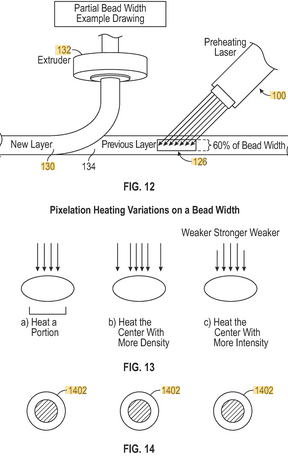The aim is to construct prior art to circumvent US11192298B2 (Stratasys)
Stratasys envisions the preheating process as follows

The projection is along the filament line and less wide than the beam width.
The laser is kept on the filament using theta control.

Stratasys seems to think it it necessary / optimal that the laser image has a width less than a commanded bead width of the bead.
I propose the following a laser prism scanner projects a line orthogonal to the filament path.
This circumvents the patent as the projection is greater than 50-75 percent of the bead width.
It also no longer requires theta control. Only the part of the scanline is used which optimally preheats the filament is required. Intensity could be altered over the filament.
It might be beneficial to extend the prism and use a plurality of emitters (lasers or leds). As it allows for a more careful preheating of the filament.
This would then bring us into the legal domain of US10114289B2 and the activities of my former colleagues (AMsystems).
You are using a plurality of emitters through a rotating prism.
As alternative a combination of two rotating prism could be used with a single laser.
A stack of laser laser prism scanners could be used. That is multiple laser prisms scanners are placed in front of the extrusion. This could be beneficial if the distance required is sufficiently large.
That it is more cost effective than a single prism with a plurality of radiative sources.
As outlined earlier, I claim all the above for the case this is done after the extrusion.
This is possible beneficial as well.
 Hexastorm
Hexastorm
Discussions
Become a Hackaday.io Member
Create an account to leave a comment. Already have an account? Log In.
I do ponder the rationale for heating only part of the filament. However, it might be just as easy to use a tiny linear actuator to adjust the laser position than use a rotating lens to change the beam path.
Are you sure? yes | no